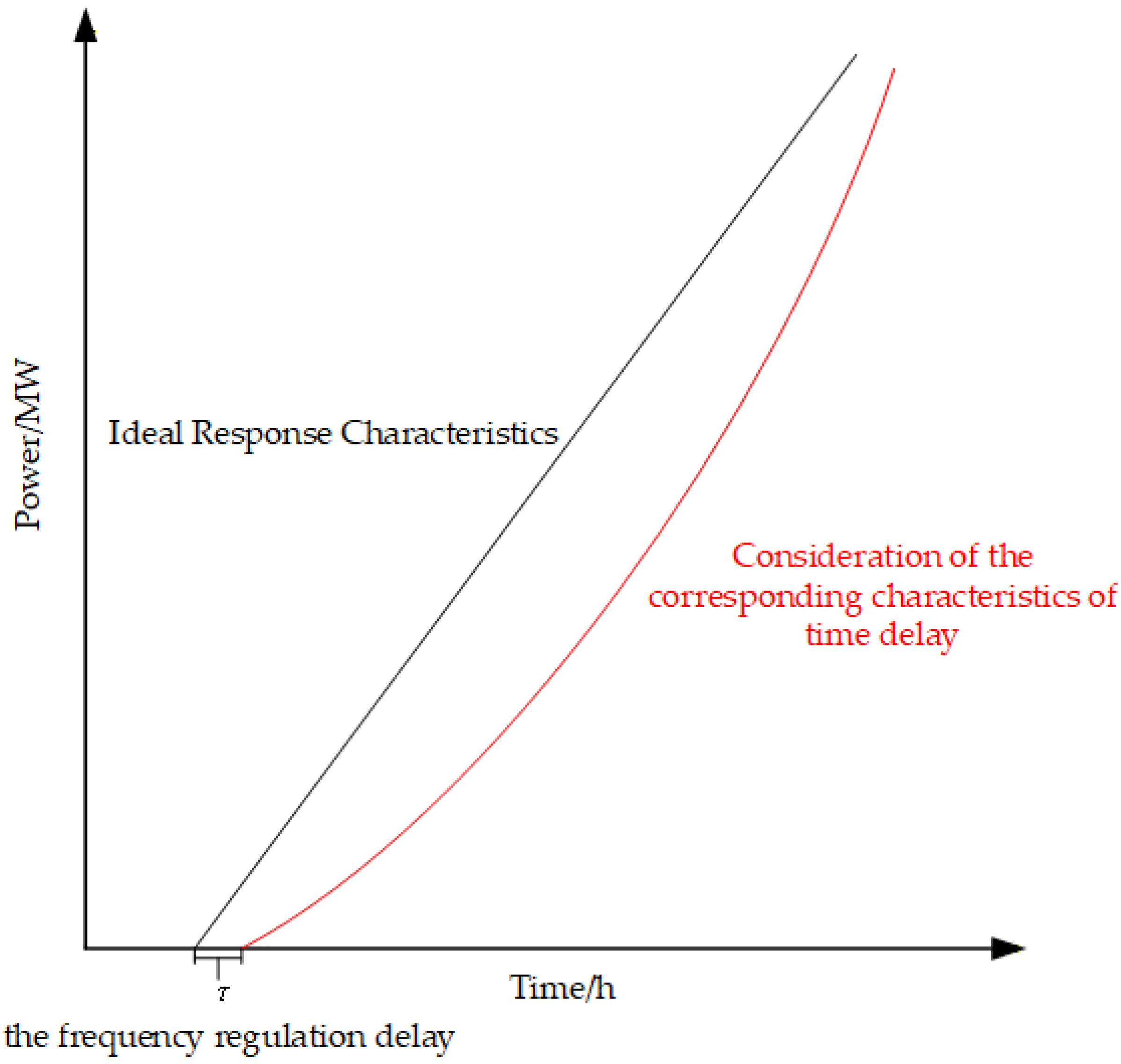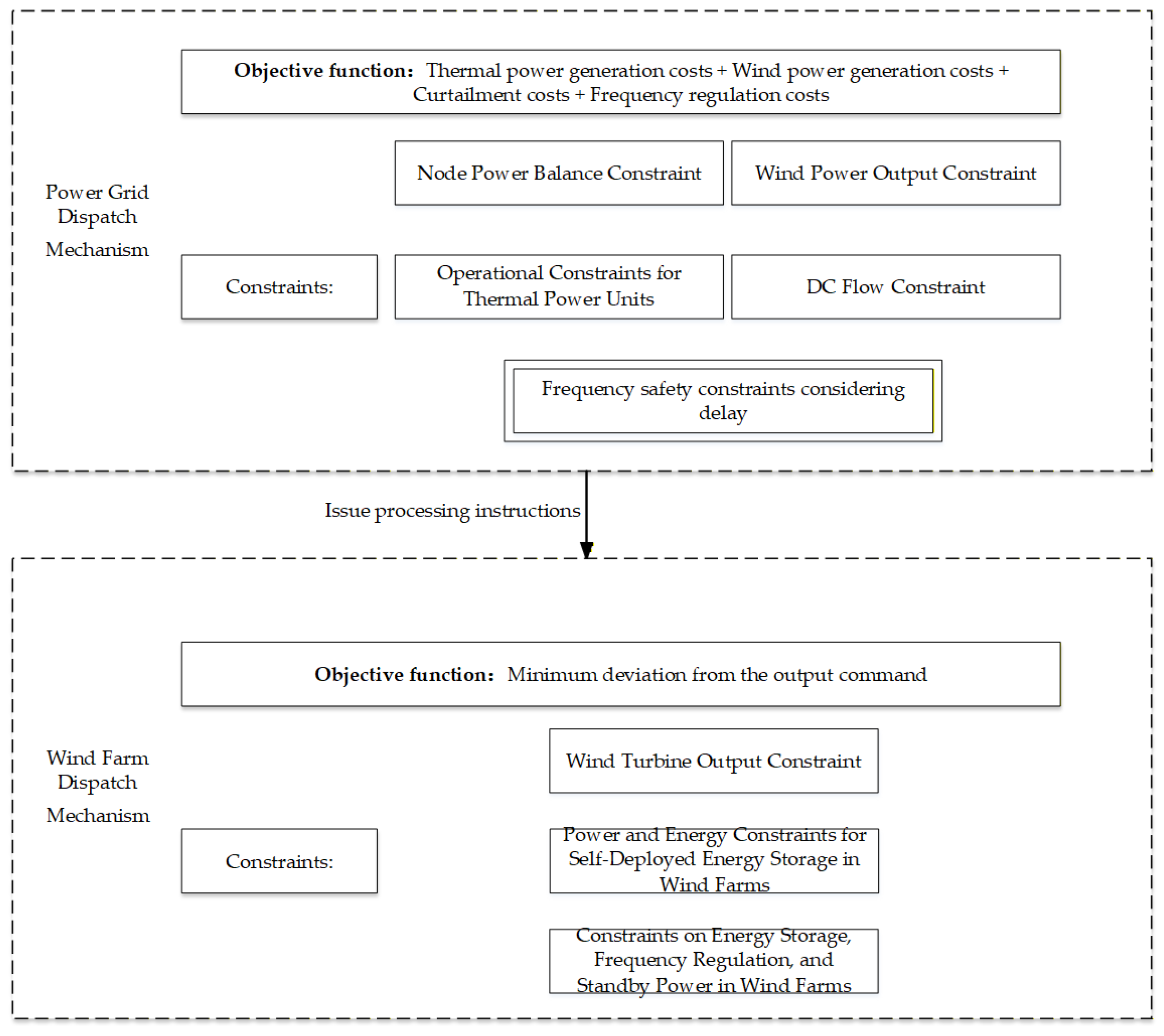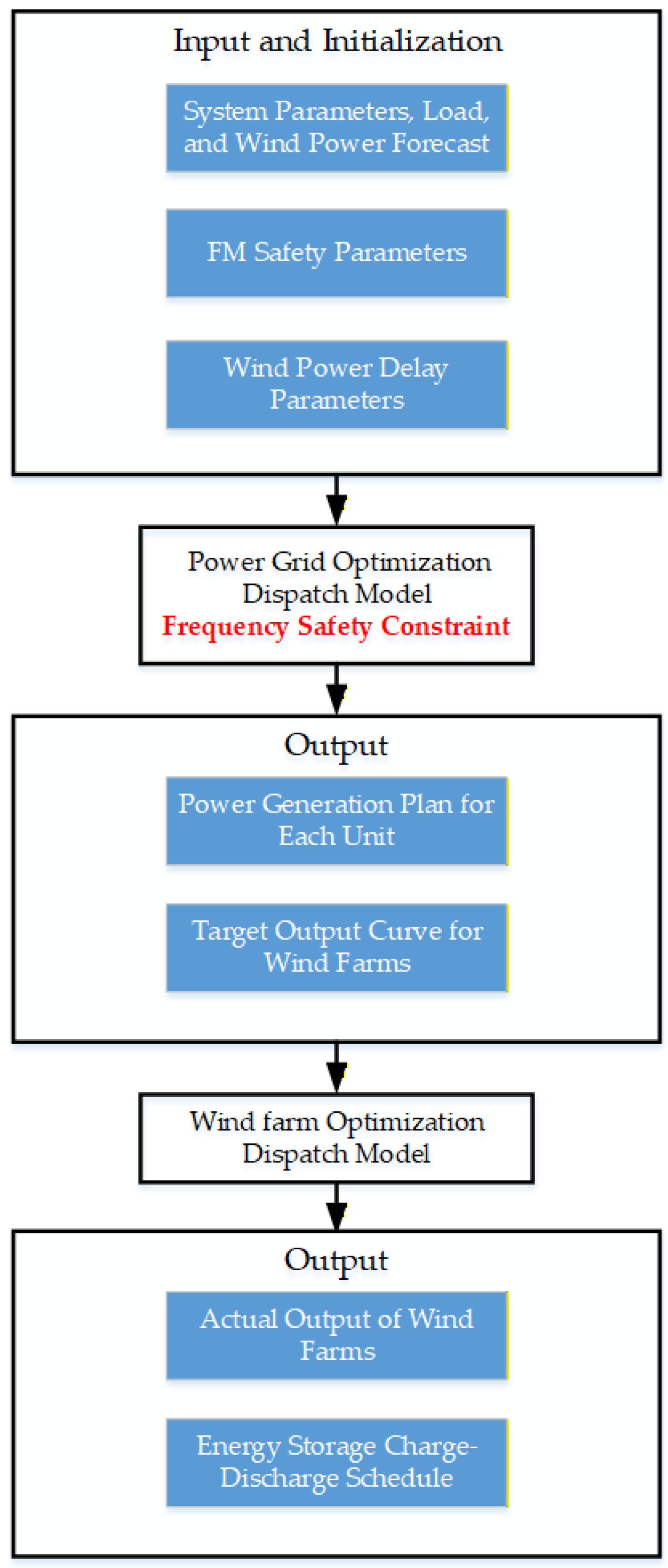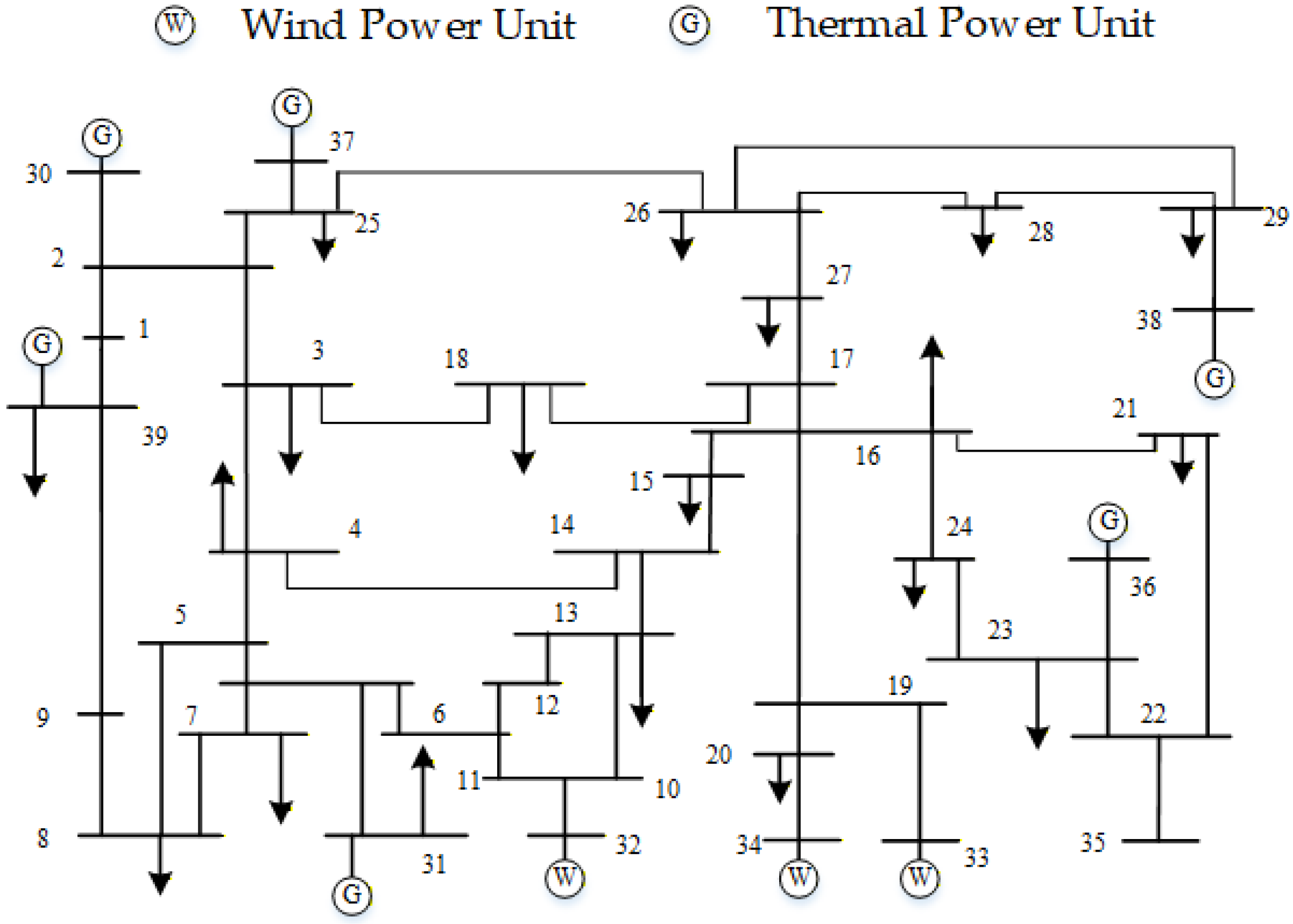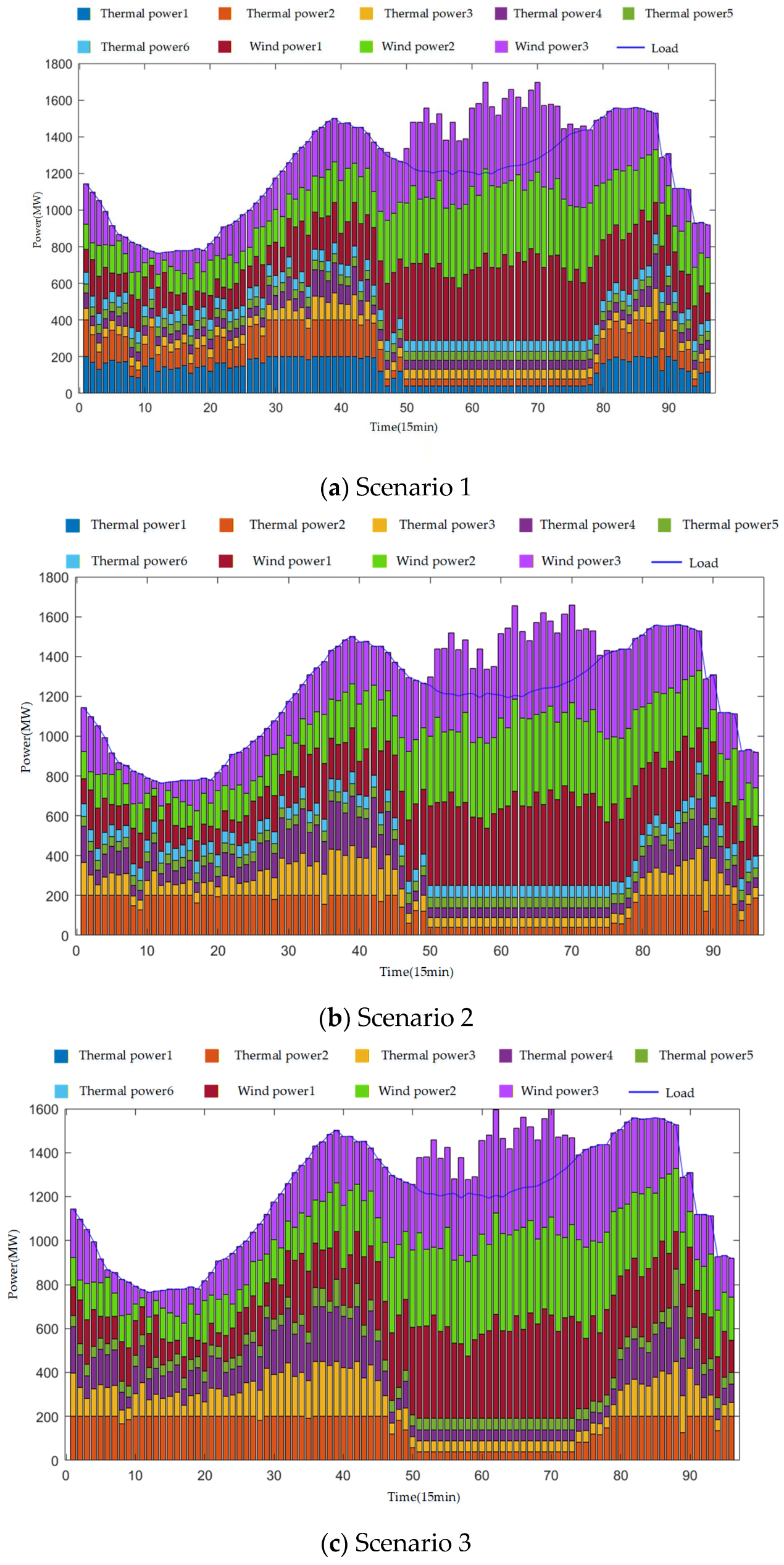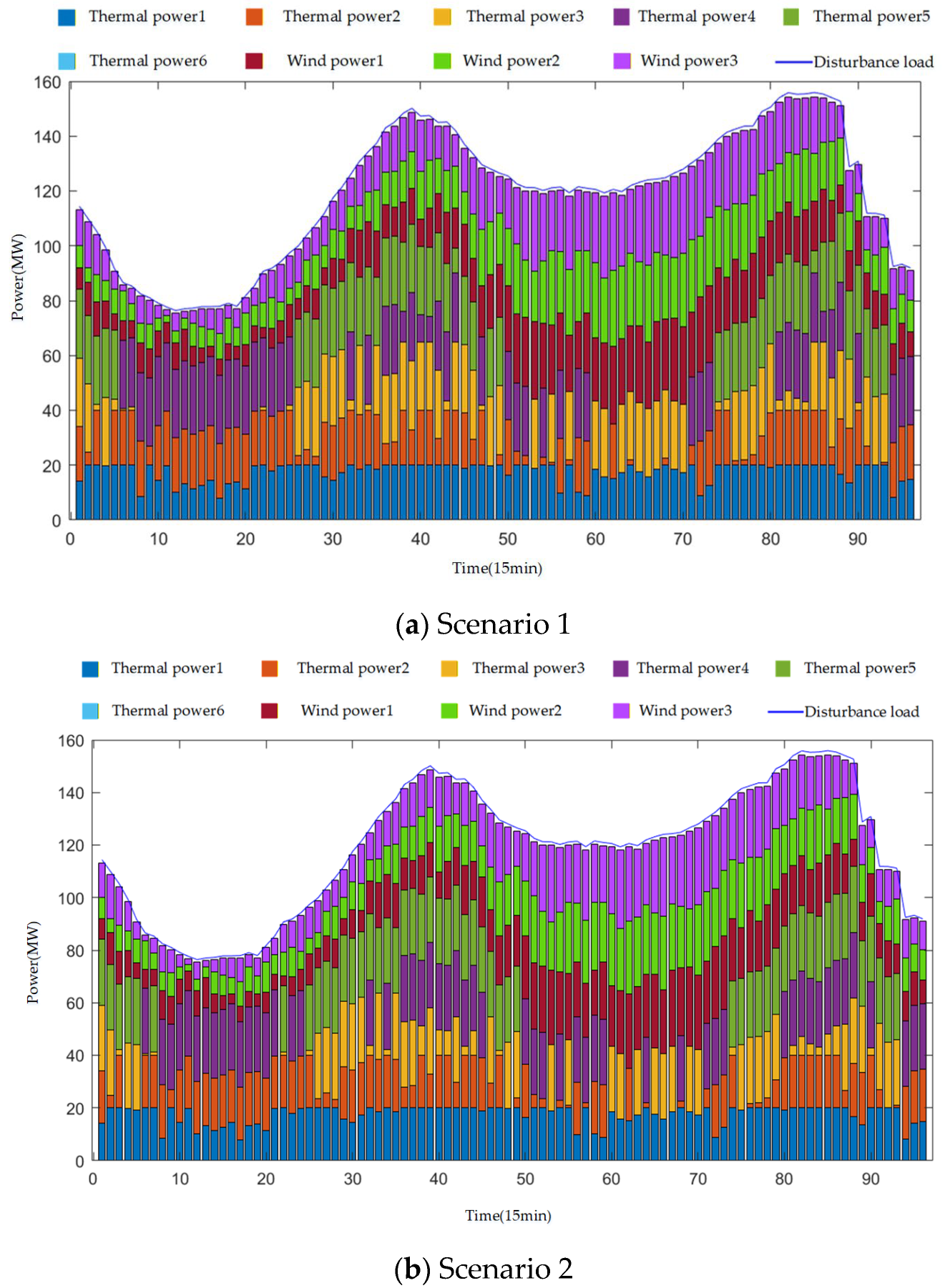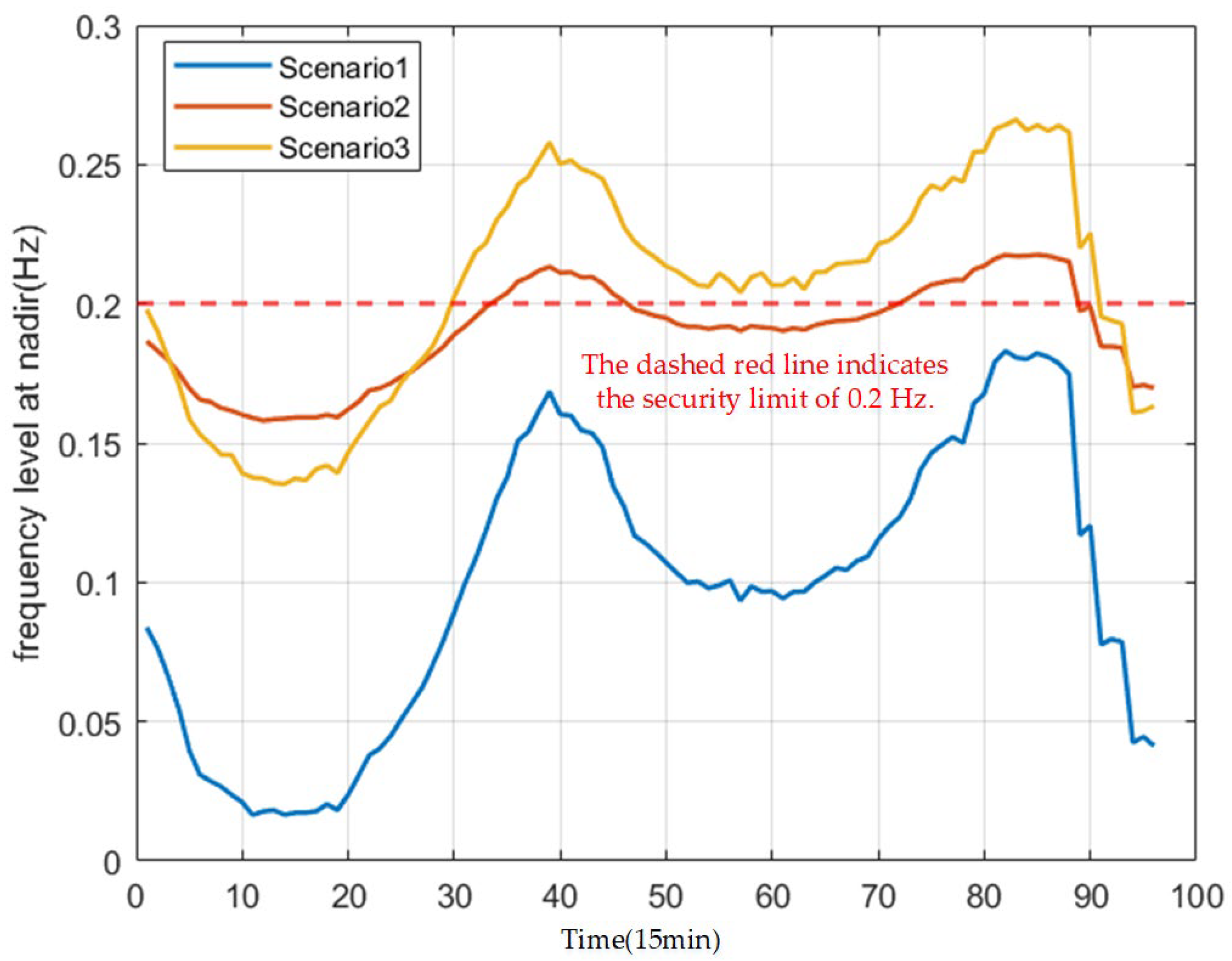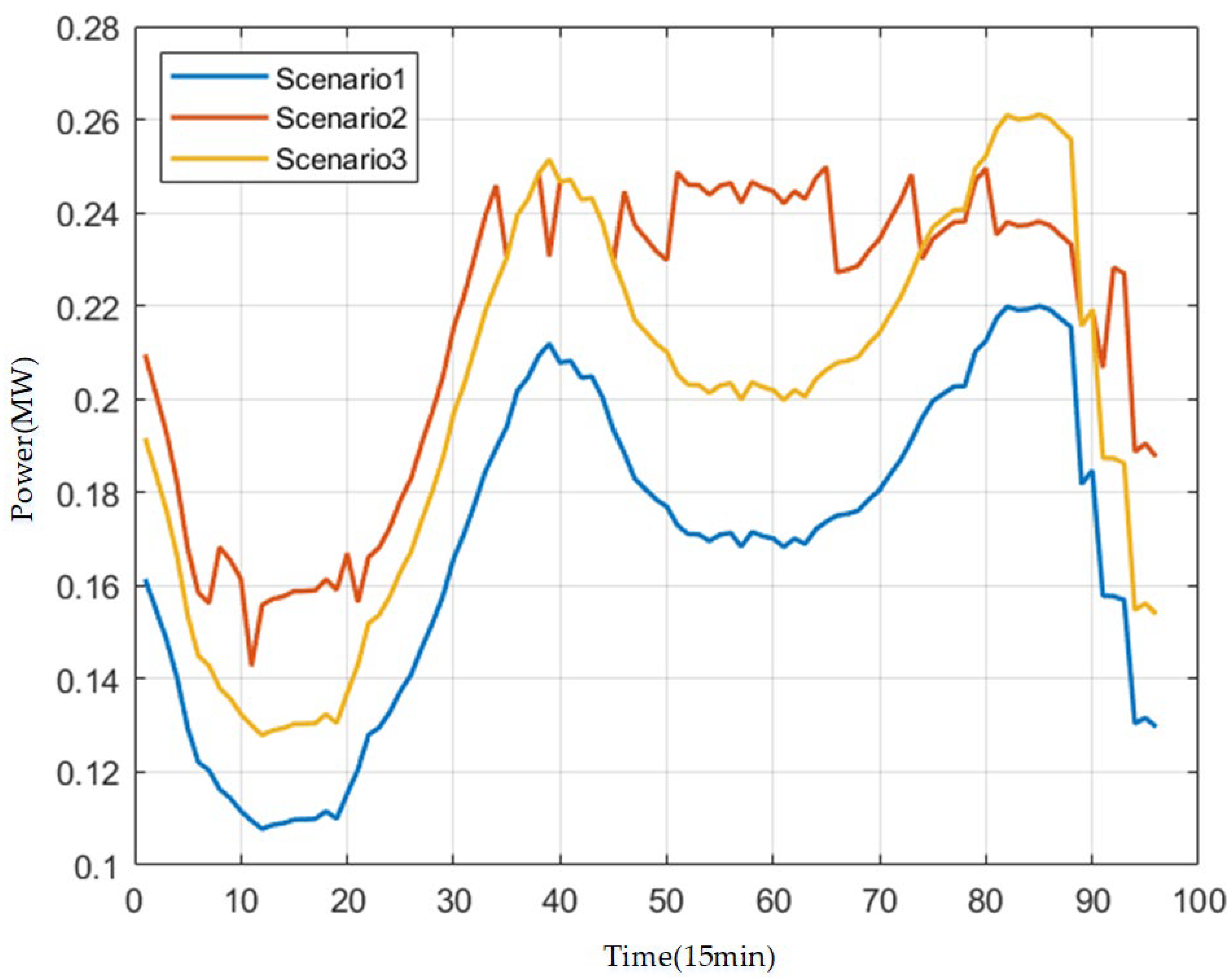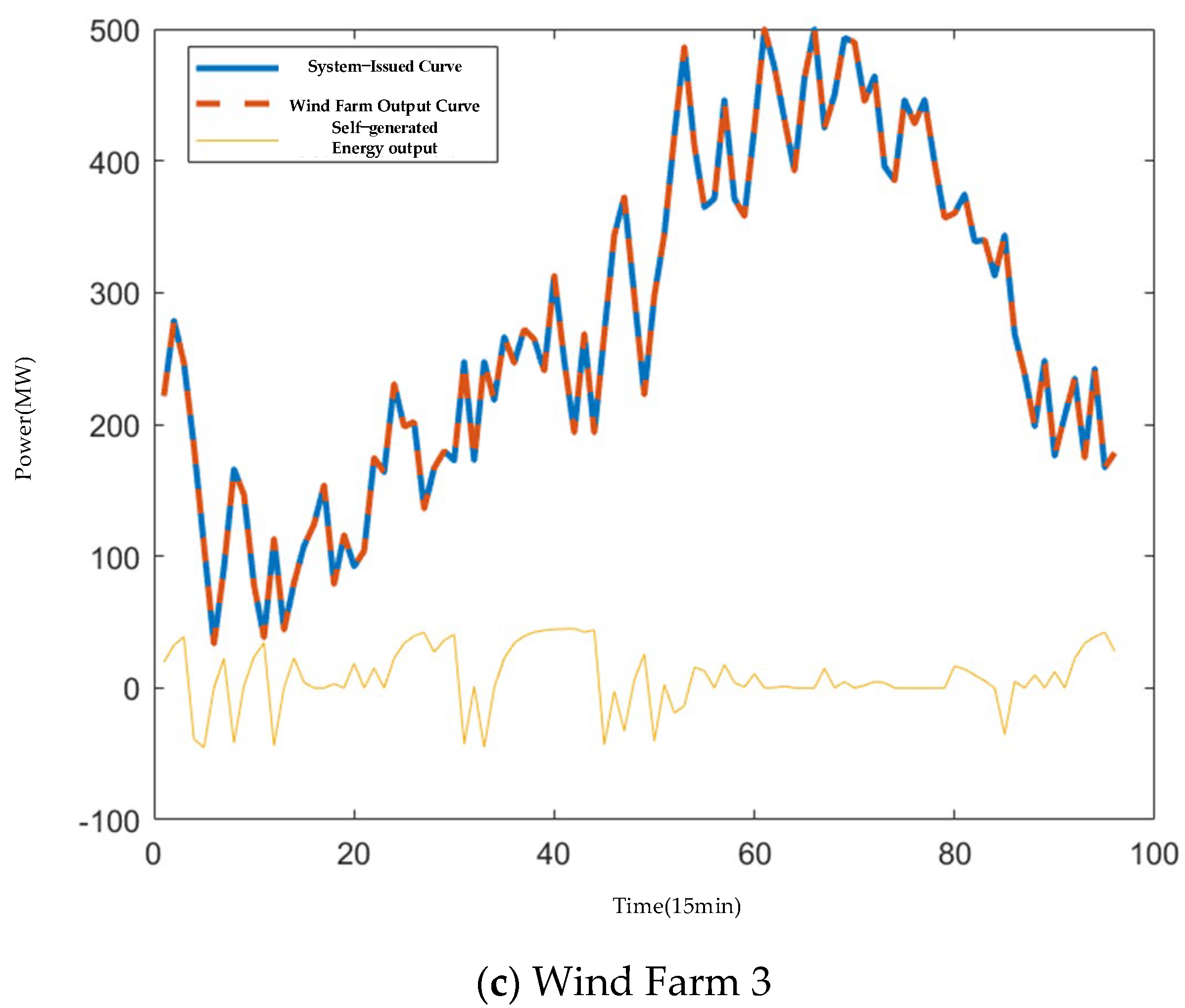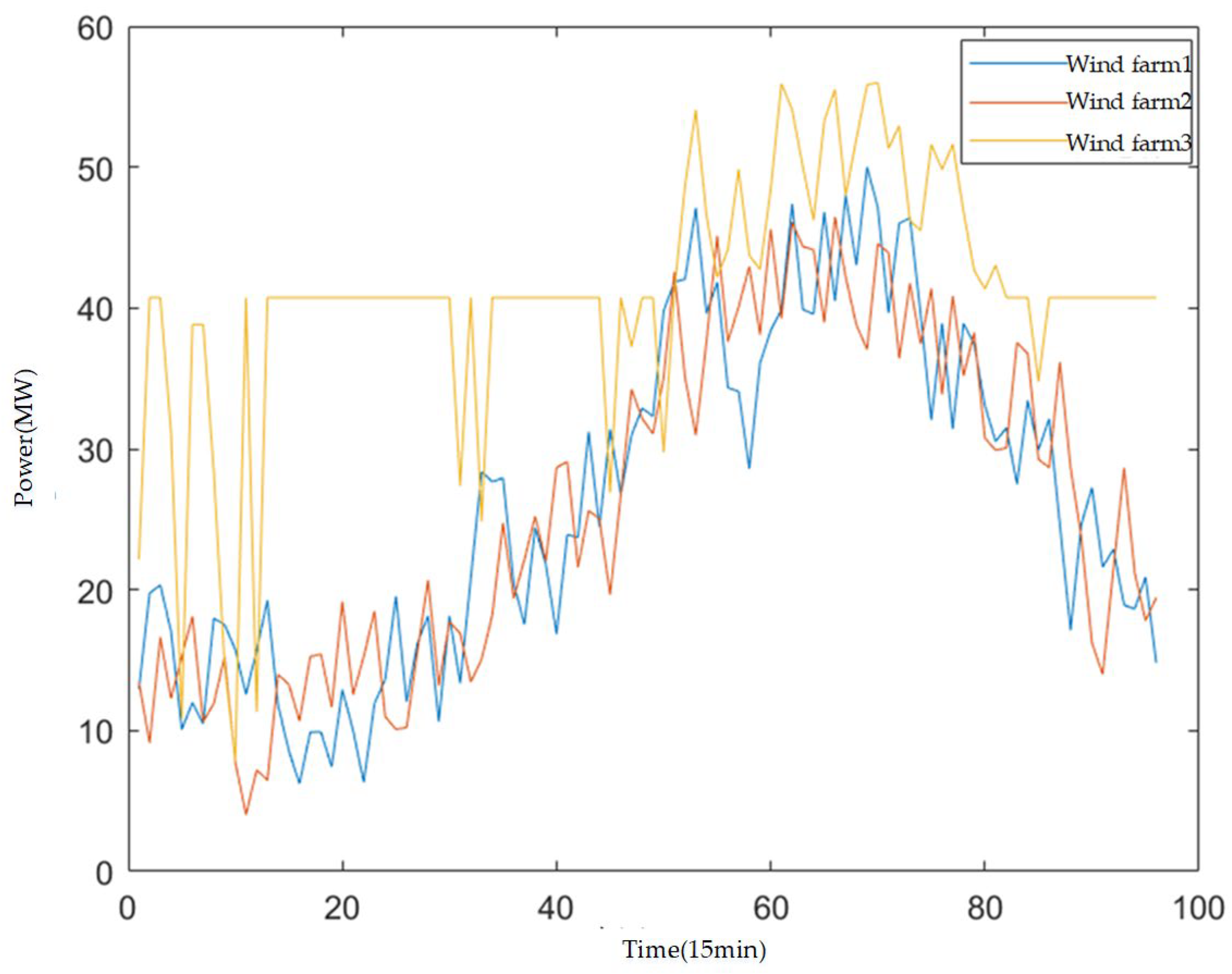1. Introduction
The global transition towards new power systems centered on renewable energy is driving a shift in wind power’s role, from passive grid integration to active grid support [
1,
2,
3,
4]. However, the inherent intermittency and volatility of wind power introduce unprecedented challenges to power system security and stability [
5,
6,
7,
8]. This is particularly critical in systems with high wind power penetration, where frequency regulation capabilities are severely strained [
9,
10,
11]. In response, several countries have instituted grid codes mandating frequency response capabilities from wind power installations [
12]. A significant challenge persists: wind turbines exhibit pronounced time delays in their frequency modulation (FM) response. Field tests from operational renewable power plants [
13,
14,
15,
16,
17] reveal that these FM delays vary substantially across different wind farms and turbine models. Originating from measurement, signal processing, and control execution stages, these delays directly impair the effectiveness of frequency regulation and the system’s dynamic frequency response. Specifically, excessive delays diminish the effective system inertia, aggravate the Rate of Change of Frequency (RoCoF), and amplify frequency deviations, thereby jeopardizing overall system stability.
Existing research on enhancing frequency stability in wind-integrated power systems can be broadly classified into three categories: control strategy improvements, system dispatch optimization, and emerging coordination frameworks. Despite these efforts, significant gaps remain, particularly in comprehensively addressing FM delays and establishing effective joint dispatch coordination.
Studies focusing on control strategy improvements aim to enhance the inherent frequency response performance of wind turbine generators. Various advanced control techniques have been proposed, including coordinated adaptive sliding mode control using radial basis function neural networks [
18], auxiliary frequency control based on functional optimization models [
19], and distributed frequency regulation methods [
20,
21]. While these approaches improve control performance to a certain degree, they largely rely on the idealistic assumption of an instantaneous wind turbine response. Consequently, they often fail to adequately account for the limitations that actual FM delays impose on achievable control performance. Although reference [
22] employed Long Short-Term Memory neural networks to compensate for time delays, its scope is still limited to control optimization at the individual wind farm level, without integration into the broader context of grid-wide dispatch.
Research on system dispatch optimization primarily focuses on incorporating frequency security constraints into power system scheduling models. For instance, references [
23,
24] integrated constraints like RoCoF and frequency nadir into stochastic generation scheduling to ensure frequency security. Reference [
25] developed a source-load-storage dynamic frequency response model for generation scheduling, while reference [
26] addressed peak shaving demands while preserving frequency security. These contributions have significantly advanced the use of frequency security constraints in dispatch models. However, the constraints formulated in these studies typically depend on the response characteristics of conventional synchronous generators or idealized renewable units. A critical shortcoming is their failure to incorporate the impact of wind turbine FM delays into the dispatch model. This oversight can cause system operators to overestimate the available frequency regulation capacity from wind power, leading to a mismatch between the optimized generation schedule and the actual delayed response from wind farms. As a result, the practical effectiveness of the dispatch plan for frequency control is undermined.
Recognizing the limitations of isolated approaches, recent research has started to explore coordinated control and fundamental shifts in system architecture. For example, reference [
27] designed an extended state observer with delay compensation for distributed optimal control, aiming to address physical constraints and time delays concurrently. A more transformative development is the advent of grid-forming (GFM) inverter control for wind turbines [
28,
29]. In contrast to conventional grid-following strategies, GFM control allows wind turbines to autonomously establish grid voltage and frequency, thereby inherently providing instantaneous inertial support and potentially alleviating the negative impacts of response delays. The validation of such advanced control strategies increasingly utilizes Hardware-in-the-Loop (HIL) testing [
30,
31], which offers a high-fidelity environment for evaluating controller performance under realistic delay conditions.
Despite these advancements, a clear and critical research gap remains: the translation of wind turbine FM delay characteristics from the local control level to the system-wide dispatch level has not been fully addressed. Specifically, studies such as [
13] focus on modeling delays but do not apply them to dispatch problems. Conversely, works like [
24,
26,
32] integrate frequency constraints into dispatch models but overlook the impact of wind power delays. Thus, effectively bridging this gap is necessary. The core contribution of this paper is to address this disconnect by proposing a joint grid-wind farm dispatch model. This model explicitly incorporates wind FM delays into the system-wide frequency security constraints, thereby ensuring consistency between dispatch commands and the actual dynamic response capabilities of wind farms.
In summary, a significant disconnect persists between the domains of “control” and “dispatch”. Research on control strategies often neglects to translate its considerations of time delays into applicable dispatch models. Simultaneously, studies on dispatch optimization frequently overlook time delays as a critical physical constraint. Therefore, developing a joint grid-wind farm dispatch model that explicitly accounts for wind turbine FM delays is essential. Such a model is crucial for aligning dispatch decisions with realistic system responses and for fundamentally enhancing the frequency security of power systems with high wind power penetration.
To address the identified gap, this paper proposes a joint dispatch model for power grids and wind farms that incorporates wind turbine frequency regulation delays. The methodology is as follows. First, a delay element is introduced into the traditional primary frequency response model of a wind turbine. This delay element is then approximated using a first-order Padé expansion, facilitating the derivation of a wind turbine frequency response model that explicitly accounts for the FM delay. Based on this enhanced model, system-wide frequency security constraints considering the wind turbine delay are formulated, and any nonlinearities in these constraints are linearized for tractability. Subsequently, a practical joint dispatch architecture for the grid and wind farms is established. Second, distinct optimization models are formulated for the grid-level and the wind-farm-level dispatch. The grid-level dispatch model minimizes total system operating cost while satisfying the proposed frequency security constraints that internalize the impact of wind FM delays. The wind-farm-level dispatch model aims to track the power output targets set by the grid-level dispatch by managing internal resources. Finally, case studies performed on a modified IEEE-39 bus system validate the proposed approach.
3. Joint Dispatch Architecture for Power Grid and Wind Farms
The integration of wind power at high penetration levels presents significant challenges to system frequency stability. To address this, a coordinated dispatch architecture between the power grid and wind farms has emerged as a crucial strategy. This architecture enhances the efficiency of renewable energy frequency regulation and ensures secure grid operation. The proposed joint dispatch architecture implements a hierarchical control structure. It decomposes frequency regulation requirements from the top down and aggregates frequency support capabilities from the bottom up. This design effectively balances overall system-wide optimization with local operational flexibility, offering strong practical applicability and scalability.
The architecture comprises two distinct levels: the grid-level dispatch and the wind-farm-level dispatch. The grid-level dispatch, managed by the main grid control center, aims to achieve economically optimal and frequency-secure coordination between thermal units and wind farms [
34]. The wind-farm-level dispatch is executed by the local controller within each wind farm. Its primary objective is to track the power output targets issued by the grid-level dispatch, while also managing internal resources to meet any accompanying frequency regulation requests. This two-way coordination—where the grid sends setpoints and requests, and wind farms respond and provide feedback on their available capacity—establishes a frequency control system characterized by high responsiveness, operational efficiency, and cost-effectiveness. The overall architecture is depicted in
Figure 2.
3.1. Grid-Level Dispatch Mechanism
Power grid dispatch centers on economic efficiency and frequency security. By optimizing the start-stop operations of thermal power units, load allocation, and the utilization of wind farms’ frequency regulation capabilities, it constructs a comprehensive frequency security dispatch model that accounts for the response delay of wind turbines. The objective function of the dispatch model encompasses four components: thermal power operating costs, wind power operation and maintenance costs, curtailment costs, and frequency regulation reserve costs. Constraints include power balance, unit operational characteristics, wind power output limitations, power flow constraints, and frequency security constraints such as RoCoF, frequency level at nadir, and frequency level at quasi-steady-state constraint.
Building upon this foundation, the power grid dispatch model explicitly incorporates the impact of wind turbine frequency regulation time delay on system frequency dynamics by introducing a time-delay response model. This enhances the system’s resilience against low-inertia disturbances. Model outputs include power output plans for each unit and frequency regulation reserve capacity at every time step, with wind power frequency regulation request information transmitted to the wind farm dispatch to support next-level optimization.
3.2. Wind-Farm-Level Dispatch Mechanism
The wind-farm-level dispatch mechanism is designed for rapid and precise tracking of the power output targets received from the grid-level dispatch. Its primary objective is to minimize the deviation from the designated power curve. This is achieved by optimally coordinating the actual power output of the wind turbines with any on-site energy storage systems. A key secondary objective is to maintain sufficient headroom (or reserve capacity) to be able to provide the primary frequency regulation (PFR) service as requested by the system, ensuring the farm’s ability to participate in frequency support [
35].
6. Conclusions
This paper has presented a joint dispatch model for power grids and wind farms that explicitly incorporates the frequency regulation delay of wind turbines into system-wide frequency security constraints. The key conclusions derived from this work are summarized as follows:
(1) Explicitly modeling the FM delay of wind turbines and deriving corresponding frequency security constraints provides a crucial theoretical basis for achieving frequency-stable dispatch in systems with high wind penetration. Neglecting this delay leads to an underestimation of the system’s actual frequency deviation and RoCoF. The grid-level dispatch results confirm that the proposed delay-aware strategy significantly improves frequency security metrics—notably reducing the frequency nadir and RoCoF—with only a minor impact on operational economics, thereby effectively enhancing system stability.
(2) The case study provides quantitative evidence of the method’s efficacy. Compared to a traditional dispatch that ignores FM delays, the proposed model reduces the average frequency nadir by 0.092 Hz and the average RoCoF by 0.048 Hz/s, while increasing the peak-shaving cost by merely 4%. This demonstrates a favorable trade-off where substantial gains in frequency security are achieved at a modest economic cost.
(3) The results from the wind-farm-level dispatch demonstrate that wind farms can accurately track the power setpoints commanded by the grid-level optimizer. Furthermore, by optimally coordinating wind turbines and energy storage, the farms can maintain sufficient reserve capacity to reliably serve as primary frequency regulation resources, thereby fulfilling their role in ensuring overall system security.
Despite the promising results, this study has limitations that suggest valuable directions for future research. First, the model assumes a fixed, pre-determined delay value for all wind turbines, which may not capture the heterogeneity and stochastic nature of actual delays. Future work could investigate data-driven or stochastic models for delay characterization. Second, the model was validated on a single, modified test system. Its performance and scalability should be further assessed on larger, more realistic networks with diverse generation mixes. Finally, extending the framework to account for uncertainties in wind power and load forecasts via stochastic or robust optimization techniques would enhance its practical applicability.
